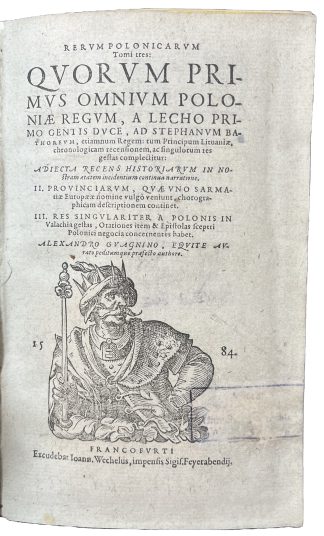GUAGNINI, Alessandro, ed.
POLAND, RUSSIA AND LITHUANIA
Rerum Polonicarum tomi tres.
Frankfurt, J. Vechelus, 1584.£5,250.00
8vo. 2 parts in 1, pp. [16], 367, [1], 720. Roman letter, little Italic. Woodcut vignettes to title and last leaf, decorated initials and ornaments. Trace of ink stamp to outer blank margin of title. An excellent, tall, clean copy in contemporary German pigskin over bevelled wooden boards, two clasps, double blind ruled to a panel design, outer border with blind roll of lozenges and fleurons, lower panel of upper cover with blind-stamped ‘1584’, centre panels with blind-stamped half-figure of Maximilian II (upper, not in EBDB, similar to m000749 and w007367) and his coat of arms (lower cover, not in EBDB), raised bands, early ms title to spine (a little scuffed), traces of old paper label at foot.
An excellent, tall, clean copy, in a charming contemporary binding, of the second edition of this most important collection of texts on the origins and history of Poland, Russia and Lithuania. It is attributed to the Veronese Alessandro Guagnini (1538-1614), who moved to Poland in the 1550s, as a military officer. An acquaintance, Maciej Stryjkowski, accused him of stealing a manuscript of the present chronicle, published in Polish in 1582, and publishing it under his own name, which even the King of Poland acknowledged as true.
Dedicated to Markus Fugger, the present collection sought to complement Pistorius’ ‘Polonicae historiae corpus’ (1582), with texts by Guagnini/Stryjkowski, Heberstein, Lasitz and others. Part I begins with an account of Prince Lechus I (700-740), founder of Poland, brother to Rus, founder of Muscovy, and Czech, founder of Czechia. It proceeds through a series of rulers – from Cracus, founder of the city, to the 1574 entry of Henry of Valois into Cracow, to be crowned King of Poland, and Stephen Báthory (d.1586). This section includes copies of several documents, connected with Henry’s and Stephen’s rule, e.g., letters, public orations and edicts concerning, among others, wars with Muscovy. It concludes with two works on Lithuania: a comprehensive chronicle and a treatise on its government. Part II opens with the famous ‘Sarmatiae Europeae descriptio’, probably also by Stryjkowski. ‘It was not obvious what was meant by European Sarmatia. Many Polish authors chose to identify it with Poland or the Commonwealth. Others (Kromer, Bielski, Stryjkowski and non-Polish authors) had a wider definition that included Muscovy’ (Watson, p.40). In addition to texts on Lithuania, the ‘Descriptio’ is followed by works on the religion of the Russians, Tartars, Prussians and Ruthenians (i.e., West-Russians). Part III is entirely devoted to short works concerning specific battles or wars, e.g., the entry of the Poles into Walachia, their wars with the Lithuanians against Muscovy, and between the Ruthenians and Livonians.
VD16 G3843; USTC 690722; Estreicher XVII, pp.483-4. C. Watson, Tradition and Translation (2012). Not in Wierzbowski.In stock






